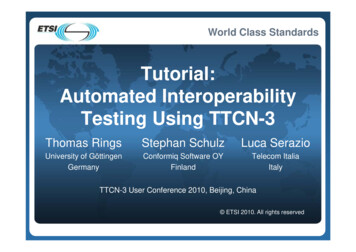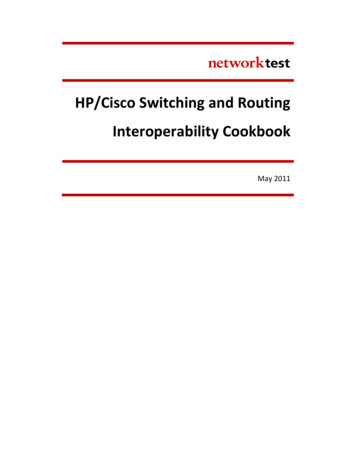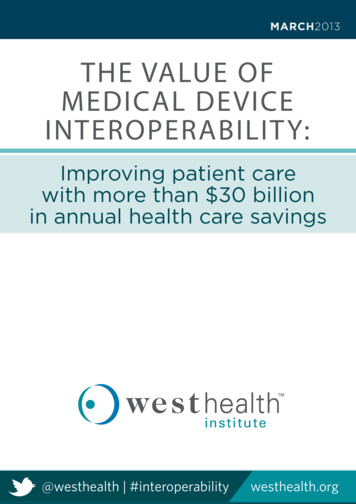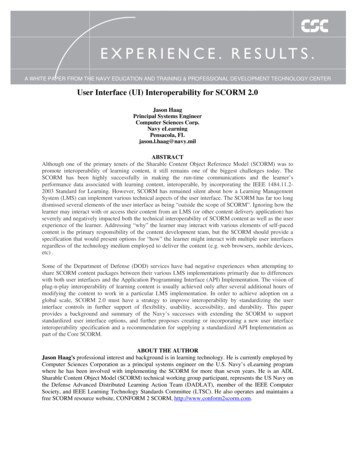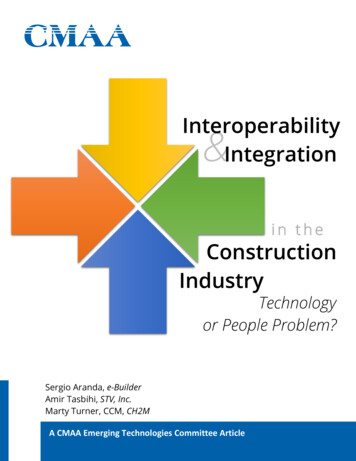
Transcription
InteroperabilityIntegration&in theConstructionIndustryTechnologyor People Problem?Sergio Aranda, e-BuilderAmir Tasbihi, STV, Inc.Marty Turner, CCM, CH2MA CMAA Emerging Technologies Committee Article
The authors have worked to ensure that all information in this book is accurate at the time ofpublication and consistent with standards of good practice in the construction management industry.As research and practices advance, standards may change. For this reason, it is recommended thatreaders evaluate the applicability of recommendations in light of particular situations and changingstandards.CMAA: Construction Management Association of America7926 Jones Branch Drive, Suite 800, McLean, VA 22102Phone: 703.356.2622Email: info@cmaanet.org.promoting the profession of Construction Management and the use of qualified Construction Managers on capitalprojects and programs.Copyright 2015 Construction Management Association of America. All rights reserved. No part ofthis publication may be reproduced or distributed in any form or by any means, or stored in adatabase of retrieval system, except as permitted by Sections 107 or 108 of the 1976 United StatesCopyright Act, without the prior written permission of the publisher.Printed in the United States of AmericaCMAA Emerging Technologies Committee Interoperability & Integration in the Construction Industry
Interoperability & Integration in the Construction IndustryTechnology or People Problem?IntroductionSystems integration and interoperability come up often as projects and teams launch newapplications to make the delivery of capital projects more efficient, more collaborative, morepredictable and most importantly, more successful. Systems integration was created becauseproject team members needed a way to share reliable data and innovative solutions with oneanother, in order to help drive decisions and improve efficiency.Modern software and cloud-based storage are incredibly powerful tools. There are manydifferent programs for many different tasks. In theory, “selecting the right tools for the job”should be enough to produce optimal results. However, as the complexity of a system grows, sodoes the potential for data silos to occur within the system. The simple truth is that thistechnology, which is designed to make our lives easier, can actually do more harm than good ifit isn’t properly managed; harm like raising project costs, causing inefficiencies, and drainingresources.Thankfully, interoperability is achievable, and there are tremendous benefits waiting to bereaped by those willing to invest in it. This white paper by the CMAA Emerging TechnologiesCommittee will provide an in-depth look at the characteristics, benefits, challenges andeffective techniques used to select the right programs for a project and then subsequentlyintegrate them all into a one, highly efficient system in order to meet your project needs. Itargues that the people using the technology present a bigger obstacle to achieving their goalsthan the technology itself.Defining InteroperabilityLet’s begin by defining interoperability. Our research team interviewed and surveyed CMAA’smembers to gauge their understanding of the terms “systems integration” and“interoperability.” We first asked members to tell us what the term interoperability meant tothem. We were happy to find that, while they did not provide a very detailed or technicalCMAA Emerging Technologies Committee Interoperability & Integration in the Construction Industry 1
response, every interviewee was capable of accurately describing interoperability in lay terms,summarized as: The ability to have one piece of software exchange information with another.This definition closely matched one by Gartner, a leading industry technology researchand consulting group:The ability for a device from one manufacturer to work with one from another.However, those we spoke to who had a technical background or who were currently involved inthe process of integrating systems, were able to elaborate a little bit more:The ability of systems to exchange information seamlessly, thereby reducing the number ofdata entry points and enabling the format of data to be modified based on the needs of itsrecipient.Interoperability in the Construction IndustryIn 2007, McGraw Hill Construction published a document titled Interoperability in theConstruction Industry that was sponsored in part by CMAA. This report provided severalexamples of the benefits, both measurable and perceived, that interoperability can provide.Our interview responses mirrored the report’s findings.Interoperability eliminates: Manual data re-entryDuplication of business functionsReliance on paper to duplicate and exchange dataInteroperability benefits include: Increased speed of overall project deliveryReduced infrastructure vulnerabilityGreater reliability of information throughout a project’s lifecycleDecreased supply-chain communication costsImproved value to customersAround the same time, the agcXML project was conducted by the Associated GeneralContractors of America (AGC) and the National Institute of Building Sciences (NIBS). Majorsoftware vendors were asked to come up with ways for building design and constructionprofessionals to efficiently and reliably exchange digital construction project information.CMAA Emerging Technologies Committee Interoperability & Integration in the Construction Industry 2
Eight years later, this issue is still very relevant. Its continued relevance is the reason why theEmerging Technologies Committee has chosen to focus on it.Different Levels of IntegrationEach of the following system integration levels discussed below are currently in use. However,we found that most respondents’ systems were at the partial integration level. Interestingly,several interviewees (particularly owners) indicated that full integration was not one of theirgoals, primarily due to the cost, security risks, or concerns about control associated with fullintegration.Level 1 – Minimal/No Integration: This first level is when projects or enterprises rely on a thirdparty program(s) to manage data exchanges. Typically, a minimal/no integration level is onlyeffective in a small, self-contained environment, such as a single department or a small office.However, unintegrated systems create problems when used for large projects. These problemsare inefficiency (added costs, drained resources, and time delays caused by individuals needingto maintain separate systems or wait for information from others), information silos (lack ofsharing) and data availability (data doesn’t exist or is difficult to find).Level 2 -- Partial Integration: This is when only certain systems are integrated with oneanother, in order to improve data exchange relevant to the specific needs of a project orenterprise. This most-common level of integration is used in both internal systems (data sharedbetween members of the same organization) and external systems (data shared betweenmultiple organizations working on the same).Level 3 -- Full Integration: Finally, full integration is when all user systems are integrated withone another and are sharing information to their full capacity. Full integration allows allstakeholders and users to reliably upload information to and download it from a single source.Which Systems Are Being Integrated?For this research, it was important for us to identify the industry’s most commonly usedsystems, regardless of roles, region or market sector. We asked CMs, PMs, owners, engineers,architects, IT Managers, professors, teachers, and industry experts working in thetransportation, water/ wastewater, healthcare, civil, heavy construction, and academicindustries which systems they used.The most common responses were: PMIS – Project Management Information Systems (owner vs. GC centric)BIM – Building Information Management softwareCMAA Emerging Technologies Committee Interoperability & Integration in the Construction Industry 3
GIS – Geospatial Information SoftwareAsset management softwareReporting and dashboarding softwareFinancial softwareScheduling softwareSpace planningInteroperability in the Building Information Management (BIM) EraSo what about Interoperability and BIM? Building Information Modeling (BIM) has differentmeanings to different people. Some scholars argue that Building Information Modeling (BIM) isan inappropriate title, because BIM is about more than just buildings or modeling. Some callBIM “Building Information Management” to place more of an emphasis on the informationcomponent than the 3D geometry component.Whatever you call it, BIM has the potential to revolutionize the AEC industry by acting as a hubfor data mapping information and integration. For example, 4D modeling (the intelligent linkingof individual 3D CAD components to time-related or schedule-related information) is a productof scheduling and BIM integration. 5D modeling is essentially 4D modeling with the added layerof a cost estimation system. Examples of additional BIM system layers include model-basedcost estimation, facilities management integration, and BIM-based PMIS workflows.Fortunately, most of the software packages used in the BIM process include some sort of API(Application Programming Interface), which allows agencies with qualified staff to create theseaforementioned extensions. APIs can perform a variety of the following tasks: Adding features to existing software to augment functionality or to customize thesoftware for individual workflowsAutomating activities within the software package to increase productivityExtracting data to further analyze or to send to other systemsPushing data from other systems into the packageLeading AEC firms have found significant value in BIM. Many have established a BIM R&D teamto develop more advanced BIM technologies, develop custom solutions, research ways tointegrate additional systems, and to educate more people within their own organization.As wonderful as this dedication to achieving BIM excellence is, it is only a starting point. Fullyunderstanding all of BIM’s capabilities will take a long time and will require a lot of effort from alot of people. Regardless of which systems are being used, it should be clear that our industry isCMAA Emerging Technologies Committee Interoperability & Integration in the Construction Industry 4
searching for a faster and more reliable way (pure stream) to share data with all project teammembers to improve decision-making, while reducing uncertainty and dissonance.Interoperability requirements must become a higher-priority topic for discussion as more andmore new systems are adopted.BenefitsThere are obvious benefits to be realized by linking systems together and having themeffectively communicate with one another. Most notably, interoperability eliminatesinefficiencies caused by: Manual data re-entryDuplication of business functionsContinued reliance on paper to duplicate and exchange dataOur study also indicates that greater efficiency and elimination of waste are two key benefitsfor CM industry professionals. In addition, any improvement-focused organization must havesufficient access to data in order to track performance.The following are the benefits that interviewees and survey respondents most commonlymentioned:Instant Access to Reliable Data and Improved CollaborationAccess to data provides a CM with the necessary information and insights into the status of aproject, the performance of a business group, or the performance of a specific process, so it isnot surprising that “instant access to reliable data” is one of the most commonly mentionedbenefits. Most agencies rely on multiple systems to track different aspects of their project; onefor estimating costs, one for planning, one for program management, one for constructionmanagement, and so on. Reports that require information to be gathered from that manydifferent sources are more time-consuming and error-prone than they need to be. Respondentsnoted that having easier access to data improved team collaboration and cut down on responselatencies to client needs.Improved Efficiency and Time Savings by Eliminating Redundant Data EntryAnother frequently mentioned benefit of interoperability is that interoperability eliminatesinstances of duplicate data entry. Many agencies use redundant systems (systems that collectthe same information into different locations). These systems require the same information tobe entered two or more times.Keith Tyson, of the Washington Suburban Sanitary Commission, was able to save his agency’sinspection team 20-40 hours per week by having data entered only once during their inspectionCMAA Emerging Technologies Committee Interoperability & Integration in the Construction Industry 5
process. To put this into perspective, a 10-20 million dollar project requires the entry of anestimated 200-300 RFIs. Imagine the time and money that could be saved by eliminating thatmany duplicate RFI entries (GC/architect/owner).Secondary Beneficial Use of Data or Sharing Data on One System for the Benefit of Other TeamsIn more extreme instances, agencies attempted to leverage information already stored in onesystem during their design and construction phase and turn that information over to theoperations and maintenance group. One such example would be taking information from a BIMmodel and moving it to an asset management system.Eliminate or Minimize Human ErrorAnother benefit of systems integration is that it reduces the number of required data entrypoints, which consequently, should eliminate the potential for human error. We frequentlyreceived anecdotes about someone taking information from one location (database,spreadsheet) and copying and pasting it into another system. Using APIs is one way thatagencies we talked to are addressing this challenge.Challenges to Achieving These BenefitsWe asked respondents to tell us about the challenges they faced while trying to integratedifferent systems, and the strategies they used to overcome those challenges.People Complicating a Simple ProcessDuring one interview, we spoke with the leader of CannonDesign’s construction services team,Gustavo Lima. Gustavo is responsible for developing and coordinating CannonDesign’sconstruction quality improvement initiatives around the globe. He frequently lectures at AIAand other similar organizations. He also authored an article titled “Message to the ProjectManagement Software Industry: You need to learn 1/issue 59.html“We put a man on the moon yet we can’t fix this problem,” Gustavo said, when asked aboutinteroperability. One example AGC used to support its data exchange schema was an RFIexchange between a contractor and an owner’s PMIS (Penta and e-Builder) at the 2006 AGCConference. Gustavo commented on this, saying “Even though an RFI is nothing but asophisticated email – to, from, date, body of text – contractor and owner systems are set up tocollect the same information differently.” This is not a software issue, it’s a people issue.One senior IT systems manager in Chicago noted that many problems start when a system’sneeds are not completely understood or aren’t clearly conveyed to all of the system’sstakeholders. This leads to frustration for users, who don’t understand why data cannot bepushed or pulled in the format that they need.CMAA Emerging Technologies Committee Interoperability & Integration in the Construction Industry 6
Most interviewees agreed that the best way to combat this problem is through effectivecommunication. Stakeholders must find a way to describe what they need from the system.Formal procedures (including roles, responsibilities, flowcharts and process maps) must also beestablished to improve the effectiveness of the system.Territorialism (Loss of Control)Another recurring challenge was the inability to integrate a PMIS with a company’s financialsystem. In some instances, an engineering team would insist that the construction team’sfinancial system not be allowed to integrate with their own (JD Edwards, PeopleSoft, Banner,others). The engineering team said that they were afraid the construction team’s financialsystem might corrupt their own financial system if the two systems were integrated with oneanother. The likelihood of integration causing corruption is minimal. Nevertheless, theengineering team steadfastly denied the construction team’s request. They even rejected aproposal from the construction team to integrate data through a batch process (in which data isdumped into an FTP site, where it is then picked up by a construction system). Groups have atendency to associate control over data with control over entire processes. This can createserious friction.VisibilitySeveral respondents expressed concern over their data being fully transparent. One agencyrecalled an instance where one of its teams continually stymied the launch of a new systemthat would create reports which offered full visibility of the team’s entire program. It appearsthat what some groups consider to be common ownership can be seen as proprietaryownership to other groups. Transparency and visibility issues need to be addressed during theintegration phase. Guidelines for what can and cannot be shared need to be formally agreedupon by all stakeholders to prevent problems from occurring later.Wrong Tool for the JobSome interviewees felt that problems could frequently be traced back to the wrong systembeing selected for a project. In order to make a sale, a vendor will frequently overstate a tool’scapabilities and ease of use or understate the time and resources needed to implement andadminister a tool. The aforementioned problems are exacerbated when the wrong program isintegrated into an existing system.“Wrong-sizing” is a similar, yet equally devastating factor to consider. Oftentimes, a vendorsalesman will persuade an unwitting CM or agency IT department to purchase a moreexpensive product that is laden with unnecessary features and functions. In this scenario, theprice for these premium programs is unjustifiable. The additional features provide no addedbenefits, yet they unnecessarily burden users with a steeper learning curve.CMAA Emerging Technologies Committee Interoperability & Integration in the Construction Industry 7
Over-CustomizationEvery project is like a snowflake, each one is unique and special, right? When projects adoptthis mentality, and many do, they tend to over-customize their tools. This results in systems andintegration processes becoming wildly overcomplicated. Applying industry best practices andstandards can help avoid expensive, time consuming implementation, minimize deploymentglitches and productivity issues, and prevent long-term system maintenance issues; all of whichcan waste valuable time and money.Integration with Non-commercial, Custom/Owner Built Project Management SystemsOver the past five-to-ten years, agencies (especially owners) have shifted away from customdeveloped systems. As highlighted earlier, Cloud-based, commercial off-the-shelf systems(COTS) will reduce interoperability’s technical limitations. As one CM put it, “If you or yourclient are still holding on to an antiquated, custom built system to manage your financial orproject data when there are so many good cloud-based tools available, you are needlesslysubjecting yourself to slow data exchange, versioning challenges, slower response times andlower overall project management performance.”Time and again, the feedback we receive indicates that most challenges to systems integrationare “people problems” instead of a technical issue, such as systems not being able tocommunicate with one another. As you will read in the “Integration Alternatives” sectionbelow, users have several options. Once the value of integration is established, the only realchallenge is to overcome resistance from other teams.If this argument is true, and technology is not the issue, why do people still interfere? Findingan answer to that question is the real challenge for CMs.Applications Now Offer More Integration AlternativesAs previously stated, the shift to the Cloud has been one of the reasons that systems are nowmore integration friendly. True Cloud systems provide a multi-premise approach, whereby allusers of the software work on the same version, as opposed to a single-premise approach, inwhich different versions of the same software are managed within the agency. Think of it interms of how you use Outlook in the Cloud: As new features are released, all users areupgraded together, and consequently benefit from the synchronous upgrade. An example ofthe old model, would be one company using its preferred data storage program (i.e. Dropbox)and another company (or worse, another office within the same company), who is working onthe same project, using an entirely different program (i.e. Google Drive).Thankfully, organizations can select from at least three options to determine how integratedthey want their system to be:CMAA Emerging Technologies Committee Interoperability & Integration in the Construction Industry 8
On Demand Import/Export – This method allows users to easily map their data to data fields inanother system, as an import file. Data exports leverage query builders. Once the desired datafields and filter criteria are selected, the report output can be easily saved to a file that can beimported into another system.This option is most appropriate when: You want to eliminate duplicate data entriesReal-time updates are not requiredOne system does not support automated integrationAutomated integration would be cost prohibitiveScheduled Batch Import/Export – This method can be done through a job-processing enginethat executes tasks at predefined intervals. Tasks can be scheduled for daily, weekly, monthlyor one-time execution. On-demand imports and exports can be scheduled for unattendedexecution by the job processing engine. Import files are automatically retrieved from onesystem’s document library or from an external FTP site while the export files can be deliveredto any combination of document folders, external FTP sites, or SMTP email addresses.Web Service API – A web service API can allow secure programmatic access to a system’s datausing industry-standard protocols such as SOAP, XML, HTTP and SSL. All project data, workflow,cost summary data and transaction detail can be retrieved or updated through the API.Integration with agcXML compliant systems requires no programming, and can be set upthrough configuration.This option is most appropriate when: There is a need for real-time data exchangeThere are a high volume of transactionsA user requires more granular control of the integration (For example, the API can beused to retrieve new invoices entered into a PMIS and record them in your accountingsystem without duplicate data entry.) Once invoices have been paid, the payment statusand details are automatically updated through the API with no human interactionrequired.ConclusionThere is still a lot of work that needs to be done in order to transform our industry into a modelof efficiency. Analysis of our CMAA interview and survey data, which was still going on at thispaper’s time of publication, reinforces the point that people are the biggest obstacle tointeroperability. Software providers have done their part by releasing integration-friendlyCMAA Emerging Technologies Committee Interoperability & Integration in the Construction Industry 9
applications. One interviewee, who represented one of ENR’s top 10 construction managementfirms, made a great point that summarized part of the people challenge.“We have a different view than owners in that the owner’s main concern is to get the projectdone, and they aren't overly interested in efficiencies if it costs them up-front money. It's morepolitical than functional resistance. Overseas, our projects are more lump sum and costsensitive for the life of the project. So there is a greater desire overseas, but fewer resourcesavailable to do it.”Developing a better understanding of interoperability and its benefits is paramount tobecoming a more integrated industry. CMAA continues to be an industry leader in sparkingdebate that leads to practical solutions. The next time you need data to help you execute yourjob more successfully, find the time to challenge other department’s leaders (IT, engineering,operations, others) to find more efficient ways to access the data. Do not accept “it can’t bedone” as an answer. Instead, ask “how can we quantify the benefits to justify any effortinvolved?” The CMAA Emerging Technologies Committee will continue to push the envelopeand find solutions for the Interoperability challenge.####CMAA Emerging Technologies Committee Interoperability & Integration in the Construction Industry 10
for data mapping information and integration. For example, 4D modeling (the intelligent linking of individual 3D CAD components to time-related or schedule-related information) is a product of scheduling and BIM integration. 5D modeling is essentially 4D modeling with the added layer of a cost estimation system.




